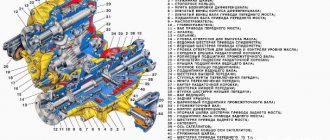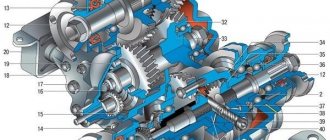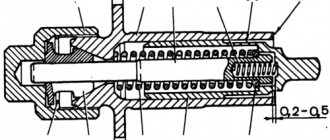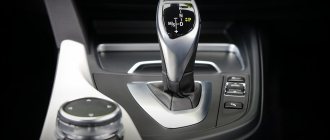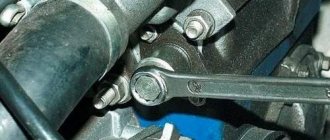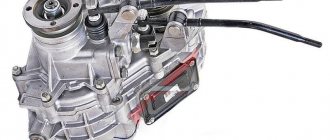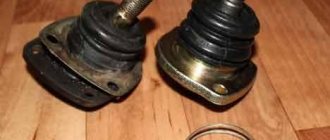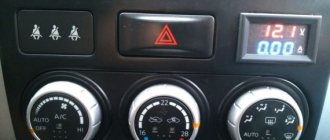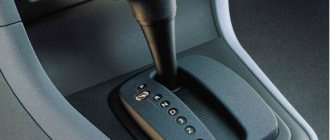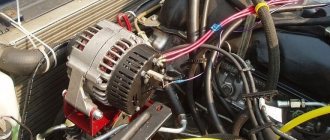Main problems with the range multiplier
The main function of the range multiplier has the properties of a gearbox divider; it turns them on or off the gear speed.
Most transfer case breakdowns are purely mechanical in nature (for example, a cut shaft between the gearbox and the transfer case). This is provoked by inattention to fuel and lubricant levels, wear of rubber bands, incorrect location (alignment) of the unit, and the condition of adjacent components. The first indicator of problems with the transfer case is characteristic noise and vibration in the body.
Vibration when driving on Niva
The first reason is that at a speed of more than 70 km per hour, it’s all about the cardan shaft; only the original one must be installed. Next, replace the crosspiece on the cardan shaft, after which you must drag the shaft to a stand and balance it, otherwise the vibration will resume.
Important: The shaft itself on the Niva lasts two years, then it must be replaced. It is better to order from the manufacturer, this is not difficult to do on the Internet.. The second reason for vibration is the intermediate shaft, it must also be original, otherwise it will quickly fail
We take only the original AvtoVAZ one from the factory, otherwise vibration and breakdowns cannot be avoided
The second reason for vibration is the intermediate shaft, it must also be original, otherwise it will quickly fail. We take only the original AvtoVAZ one from the factory, otherwise vibration and breakdowns cannot be avoided.
The third reason for vibration is the breakdown of the gearbox flange bearings. To eliminate the problem, place additional support on the gearbox.
How to overcome noise when maneuvering in a transfer case
You can buy new handles for the levers. We change it ourselves, prying up the support with a screwdriver, take out the lever axis and get rid of the old handles. We remove the old lever springs and install new ones. Insert the lever axis and secure it with a corkscrew nut. Now, when driving with the new handles, there is no characteristic noise in the cabin. The handles can be easily changed without leaving the salon.
Stiff switching of the lock lever
This issue can be easily solved in the following way: when driving, just turn the steering wheel slightly and the lock will immediately turn on without any problems.
There are also: jamming of the pneumatic cylinder, sticking in the neutral position, or the rod is sitting tightly. Burnt gear and shift fork.
Transfer case for Niva, signs of breakdowns:
- problematic engagement of the front axle;
- overheating of the range multiplier;
- leakage or excessive consumption of oil during operation of the transfer case;
- self-switching of the front axle.
Repairing the transfer case in Niva 21213 with your own hands is quite possible in case of minor breakdowns. The owner of a Chevy Niva will only need the basic skills of a car mechanic. It is more difficult to correctly install and center the Niva transfer case. Here it is still recommended to contact a car service. A diagram of the unit itself is presented in the vehicle documentation.
About the device
The transfer case is not present in all VAZ passenger cars, but only on cars with two drive axles. In the transmission, the transfer case (TC) is installed at the rear of the gearbox; a rear driveshaft is attached to its shank, which connects the transfer case to the rear axle. The front axle is also driven by the steering wheel; it is connected to the transfer case by a front driveshaft.
The reduction gear in the Republic of Kazakhstan is designed to obtain high torque, it is used to overcome difficult sections of the road, and helps to cope with off-road conditions. The VAZ Niva transfer case contains the following main parts:
The VAZ 2123 transfer case is installed at the rear of the gearbox and is attached with brackets to the bottom of the car. It is driven by an intermediate shaft. Torque from the drive shaft to the drive axles is transmitted by cardans, which are screwed to the flanges of the transfer case drive shafts.
The transfer case body is made of aluminum alloy. In its upper part there is a hatch with a lid.
The transfer case consists of the following parts:
The Chevy Niva transfer case has three speeds:
Neutral allows you to temporarily disengage the gearbox from the transmission. It is used when connecting a winch and other units to a vehicle.
The first speed is intended for on-road driving, and the second is for off-road use where high torque at low speed is required.
Despite the difference in varieties, the structure and operating principle of these boxes are the same. How does the transfer case (Niva Chevrolet) work? This node includes several elements:
All this is controlled from the interior. There is a transfer lever for this. "Niva Chevrolet" has both locking and downshifting. The torque that goes from the main transmission to the transfer case is transmitted through the drive shaft.
The differential lock on the Niva is a faithful assistant to the driver
All-wheel drive does not always provide off-road capability. Often this is not enough. When, as on the Niva, the locking works in conjunction with all-wheel drive, we can say that the car is at least close to all-terrain vehicles. And with such a car it is quite possible, if not to conquer the muddy roads, then to move quite safely along country and abandoned roads.
But do not forget that differential locking is a mode for difficult driving conditions. But there is no need to be afraid of him. We must remember that blocking allows the Niva to drive where others will not even try to do so. But you shouldn’t turn it on unnecessarily in the city. This is fraught with excessive gasoline consumption, tire wear, and ultimately, car breakdown.
Design and principle of operation of the Niva 2121 transfer case
The transfer case mechanism includes more than 60 independent parts, which is confirmed by the presented drawing. Therefore, it is quite prudent to name the main elements and their purpose.
- Housing Differential housing Shafts Couplings Seals Pinions Gears Flanges Levers
A pair of gears are tightly seated on the drive shaft, one of them (large) is intended for high gear, the second (small) is responsible for low gear. They have serrations with straight and oblique profiles. The first ones are in contact with the coupling, the second ones - with the intermediate shaft. The inclusion of one or another row causes the coupling to move along the hub in the horizontal direction, after which it is connected to the gear on the transfer case drive shaft.
The intermediate position turns off the gearbox (the gearbox is open), and the vehicle cannot be moved in this mode. The front helical gear on the intermediate shaft is used to control the differential. The locking is engaged, or the rigid coupling of the drive shafts of both axles, is carried out through a clutch. The design is typical for modifications 21213 and 21214, and the latter is additionally equipped with a speed sensor drive.
In the operating state (with the transfer case reduction gear connected), the gear ratio in the first stage changes from 4.4 to 7.83, the second - from 2.52 to 4.58, the third - from 1.63 to 2.9, in the fourth - from 1.2 to 2.14, fifth - from 0.98 to 1.75, which is expressed in an increase in traction on the wheels.
Vibration
Vibration in the body is the main “disease” of the Niva; it often occurs due to improper alignment of the transfer case. Most often, vibration occurs on VAZ 21213/21214 cars, since the transfer case is mounted only on two supports on the sides of the body; on the Chevrolet Niva, the transfer case is already installed on three supports.
Vibration when starting off on a Niva can also occur for the following reasons:
Installing the third support of the transfer case on VAZ 21213/21214 vehicles allows you to reduce the level of vibration of the transfer case; with this support it is easier to center the transfer case. The part can be purchased at auto stores or made yourself. The finished product comes with three long studs (for model 2121); to install the third support on this machine, you will need to unscrew the short studs from the transfer case housing and install new studs from the kit. We carry out repairs as follows:
Vibration is eliminated more effectively by installing a subframe under the transfer case. You can also make such a device yourself or buy a finished product at a car store.
In order to install the subframe, the transfer case must be removed. It is more convenient to carry out such work in a pit; we carry out repairs as follows:
How to use a transfer case in a field, box design
The relatively complex scheme for distributing torque from the internal combustion engine to the wheels is explained by the universal purpose of the Niva 2121 - if used correctly, it can be used comfortably in the city and along muddy country roads. Such properties are ensured by the presence of a transfer case with a center differential lock, complementing a 4- or 5-speed manual transmission, depending on the year of manufacture. The lever located closer to the dashboard is responsible for turning off/on the center differential, the second “small” lever controls the range multiplier and has 3 positions: high and low rows, as well as neutral.
A few words about the Chevrolet Niva transfer case
I think it’s time to talk about the transfer case of the Chevy Niva, because those who just bought this car, at the very beginning of use, do not really know how to use the transfer case, what the rules are, and in general, when to lower the gear and when to lock it. Let's figure it out now. It’s a pity, of course, that I didn’t record a video on today’s drive along a fairly washed-out road. Well, never mind, I’ll record it and show it clearly on video. For now, in words.
In general, the transfer case switches to a lower gear, as well as to lock, and it is possible and even necessary to do this at the same time. It’s convenient on the Shevik - this is done with one lever.
Turn it down - right up. Add lock - Pull the lever all the way to the left. Look at the switch handle, it's written there. Letter designation - L(low) - low, N - neutral, H(high) - high, that is, normal.
It looks something like this - we are driving across the field in normal second/third gear. Suddenly there is a terrible puddle ahead. We stop and turn down the car.
You may ask - how long does it take to turn on the blocking and then turn it off? There is another nuance here - very often, many owners of the Chevrolet Niva have a problem with the blocking - it does not turn off. It just jams and that’s it, you have to drive on the highway with the blockage. This, you understand, is very harmful for the machine and in such cases you must turn it off.
In bright sunny weather it is sometimes difficult to see. Be careful. Well, about turning off the center wheel - I managed to turn it off just when reversing. Needless to say, now I turn it on only in the most dire cases. In the rest of the others, lower gears are quite enough for me.
Just today I went to the lake to check if the ice had melted. The road was washed out, the snow had already melted and turned into liquid mud, and it’s not safe to drive through such mud on my AT tires. It feels like it’s being dragged in all directions, but the most important thing is that I’m driving, I don’t get stuck, and sometimes the ruts were almost to the very bottom; when you shuffle, it always becomes unpleasant)) After some short drives, the car looked “military-like” - all covered in mud , went to the city - people look around))
And here’s another observation of mine: it’s better to drive through mud slowly but surely. This applies to lower gears - if the mud is serious, then I always drive in first, pushing hard, trying to feel the wheels spinning in the mud. If you accelerate a little, you can immediately “burrow”, this is the case when there is no hard covering under the liquid mud.
When you turn on the second lower gear, the car accelerates, but if you get into a mud hole, there is a risk that the engine will “choke” (it is very difficult to spin the wheels in the second gear when stuck) and you will stall. Needless to say, stalling in a deep puddle can be dangerous. Therefore, if you decide to overcome a puddle or muddy area with acceleration (very often this makes sense), then be prepared in the middle, if you suddenly start to fall through, immediately switch from 2 to 1 low, so as not to stall.
All this knowledge - when to go in first and when in second, when to turn on the lock and when not necessary - all this comes with experience. You’ll ride in the mud and you’ll already begin to understand that it’s better to take the puddle over there with acceleration without locking, and that clay hill with potholes - only at 1 lower gear and with the locking on. Think with your head first, and don’t rely on the car to pull it out. The Chevrolet Niva is an excellent car, if you don’t be stupid.
Therefore, one more rule (which I always adhere to) - if the place is dangerous, there is a risk of getting stuck, then get out of the car, poke it with a branch, find out the depth of the puddle, rut, feel for a solid place where you can drive. This is the job of the navigator, so let your partner get out of the car and don’t be lazy. Spend 5 minutes on reconnaissance so that you don’t have to spend several hours later getting out of an ambush.
When to downshift?
How to use the transfer case on a Chevrolet Niva, why and when to turn on low and lock? This seems like a trivial but serious question. It's simple. Just imagine, you are driving along a country road in fourth gear - the road is wonderful, but then a deep puddle appears in front of you, where, naturally, the road surface is soft and the car will sink. To do this, you need to stop and engage a lower gear. You are not mistaken, but you really need to stop.
The whole reason is that there is a center differential that simply will not allow you to switch from high to low and back. Why do you need a downshift at all?
Just imagine - you need to drive along a soft or heavily polluted section of the road. For example, you are driving in second gear and begin to feel that the car is heavy and something is slowing it down, you switch to first, but it is still hard for it, that’s what a lower gear is for.
The first downshift is like half the first upshift, that is, if you shift to the second downshift, you get the first upshift.
As a rule, low gear is designed for off-road use. When the low gear is on, you need to drive and it is advisable not to accelerate sharply, because at this moment the wheels receive a large load and can make a fatal hole that will not allow you to move further.
In this case, the car allows you to feel the movement of the wheels and if they start to dig in, you will immediately understand it by the chaotic movement. In this case, if you notice in time that the car is starting to slip, you can do something to avoid an ambush, for example, change the trajectory.
Also interesting: How does all-wheel drive work on Niva 2121?
It is worth paying attention to the fact that if you are driving through deep puddles or sticky mud, then in no case should you sharply switch to the second lower gear, since the car may simply “choke” when the torque increases, which means it will become difficult for it and it will simply stall at the most inopportune moment.
If you are driving, for example, in third gear and feel that the car is becoming heavy, then you should immediately switch to second or even first, so as not to stall in the most dangerous place.
How to change gears and transfer case Niva VAZ 21213, 21214, 2131 lada 4×4
(see also on this topic Driving a car and What is all-wheel drive, as well as Niva driving techniques)
TRANSFER CASE SHIFTING
Transfer case levers and their positions
The gear shift lever in the transfer case can occupy the following positions:
H - low gear;
N - neutral position;
B - top gear.
The differential lock lever in the transfer case can occupy the following positions:
P - differential unlocked;
B - differential is locked. When the lever is moved to this position, a warning light comes on in the instrument cluster, warning that the differential is locked.
NOTE Shifting from low to high gears and locking the differential can be done while driving with the clutch disengaged.
It is recommended to engage low gear in the transfer case after the vehicle has come to a complete stop and with the engine disconnected from the transmission.
To overcome difficult sections of the road, block the differential in advance. Do not lock the differential when the car's wheels are slipping. After overcoming such sections, unlock the differential - driving the car on good roads with a locked differential shortens the life of the power transmission mechanisms, increases tire wear and fuel consumption, and when braking the car can lead to skidding.
SHIFTING TRANSMISSION GEARS
Gear shift diagram (also printed on the handle)
Before driving, check the position of the transfer case levers - it must correspond to the road conditions. Start driving in first gear and, as the crankshaft speed increases, move to higher gears in a timely manner.
In time and in accordance with the road situation, change to a lower gear in the gearbox, avoiding overloading the engine.
To move in reverse, press the gear shift lever, pushing it all the way down and move it to the position corresponding to engaging reverse gear. Engage reverse gear only when the car is completely stopped.
Video
lada-niva.ru
Differential locking
This mechanism is a kind of distributor of traction forces coming from the engine to the wheels.
An important feature is that the latter have the ability to rotate at different speeds. The importance of having a differential mechanism is due to the fact that during turning maneuvers, the wheel located inside makes fewer revolutions when compared with the number of turns of the outer one.
When the car moves on a flat road and in a straight line with differentials, the traction force is divided equally between all 4 wheels. If there is insufficient adhesion of the wheels to the surface or slipping occurs, the differentials will redistribute the load on the slipping and sliding wheel so that the first receives more force, and the second, accordingly, less.
We have already mentioned UAZ. Despite many similarities, it should be understood that the VAZ’s all-wheel drive is made in the “pat-time” style. This means that when connected, the axes are firmly connected to each other, and rotation occurs at the same speeds. This device imposes some restrictions on the use of all-wheel drive - it can only be used in cases where road conditions allow slipping. In cases with hard asphalt roads and highways, it is recommended to switch the car to single-drive mode.
Sometimes you can come across a misconception about why a small handle is needed next to the shift lever on a Niva. Some car owners believe that it is needed to connect front-wheel drive. However, the front-wheel drive of this car is permanently connected. As is the rear one. Cars of the Niva family have permanent all-wheel drive. The handle actually serves to switch the operating modes of the differential of the transfer mechanism.
In the “forward” position, the differential operates as usual, but if you move it back, the differential is locked, and the forces from the motor are applied to the differentials of the axles, which makes the drive more rigid. It is worth noting that there are also special types of locks for front and rear axles.
In theory, when used in conditions where the car is stuck, it will be able to overcome the obstacle if there is sufficient traction on at least one wheel. In this case, it is better to lock the differential before overcoming an obstacle, but never after entering an area that is difficult to overcome. This application of locking will avoid wear and damage to the transmission.
Gear Modes
Let's take a closer look at how to use the transfer case on a Chevrolet Niva. It serves to switch to a lower gear and also blocks the center differential; this can be done at the same time. In order to engage a lower gear, you need to shift the lever to the right and up; to lock the lever, you need to pull it to the left all the way. The handle has the following designation:
- Low(L) - decrease;
- N-neutral;
- High(H) - normal, increased.
Low gear is engaged at a speed of no more than 5 kilometers per hour, or after a complete stop. In order to overcome a steep climb, or when driving where there is soft ground, so that the vehicle speed is minimal and at the same time stable, a lower gear must be engaged in advance. For example, if you are driving on a flat road in second or third gear, and a bad section of road appears in front of you, you need to stop and shift to a lower gear.
It is not recommended to turn on the center differential at high speed, since the car may skid strongly at the moment of switching. It is advisable to block where there is a slippery surface and the wheels begin to slip.
These include:
- Switching the transfer case should only be done when the car is not moving.
- You can also engage the differential while the vehicle is moving.
- You can switch to a lower gear while the car is moving.
- To ensure long-term and uninterrupted operation of the differential, it is necessary to periodically turn it on, especially in winter. This should be done once every 7 days.
Among domestic car enthusiasts, the Chevrolet Niva is a fairly popular SUV that appeals not only to fans of extreme driving, but also to fans of measured driving outside the city. Many people know that one of the features of a car of this brand is the presence of a transfer case in it.
Using this unit, you can enable downshifting, locking, or two functions at the same time, depending on the conditions. The question of how the Niva Chevrolet transfer case should be used correctly is of interest to many happy owners of such a vehicle and those who only intend to purchase it.
It should be immediately noted that you can engage both the lock and the transmission at the same time using the Chevrolet lever that changes gears. So, the lever shifts to the right, and then immediately up to engage a lower gear. To switch back to higher, the lever should simply be moved back.
Using a Niva Chevrolet transfer case, in addition to the above, neutral gear is also engaged, while the car will remain reliably in one place. The lock can be engaged at any time - in normal gear, in low gear - just switch the Chevrolet lever to the left.
This mechanism can operate in five modes:
- Neutral is on.
- The differential is unlocked when the "lowering" is turned off. In this case, the torque is distributed in a ratio of one to two.
- The differential is locked when overdrive is engaged. Here, torque distribution is carried out automatically, depending on the quality of wheel grip on the road.
- Downshift is engaged and the differential lock is disabled. The transfer of forces occurs in the same ratio as in the first case.
- The differential is locked and the gearbox is engaged. In this case, all axles are rigidly locked together, including the axle shafts. Torque is produced unevenly, depending on the type of road surface (dirt, sand, etc.). In this mode of operation, the best cross-country ability of the vehicle is achieved. But driving with a constantly engaged downshift and with locks will not work. This increases the load on the transfer case bearings. The Chevrolet Niva will soon require serious intervention in the transmission. Fuel consumption also increases significantly, which greatly eats up the tires.
When to use low gear
How to use the transfer case on a Chevrolet Niva is a question that many owners of this car ask.
The Chevrolet Niva is a popular Russian SUV not only among extreme driving enthusiasts, but also for those who use the car for personal purposes. Everyone knows that the car is equipped with a transfer case, which is responsible for engaging the lock and downshift. It is worth noting that all this can be done even simultaneously and this is done using one lever. So, in order to use a lower gear, you need to shift the lever first to the right and then up, but of course, in order to engage in a higher gear, you just need to shift the lever back.
Note that the transfer case can be used to engage neutral gear, which will prevent the car from moving. You can engage the lock both in high gear and in low gear; to do this, you just need to switch the lever to the left.
There is a diagram on the shift lever. To engage a downshift, you need to move the lever to the right, up. To lock the differential, pull it all the way to the left. There are also Latin letters on the lever. So, L is a low gear, N is neutral, and H is high.
By switching the operating modes of the transfer case, you can adjust the behavior of the car in accordance with road conditions.
Low gear is used in two cases:
- It is necessary to ensure low speed. For example, if you need to drive onto a curb or other obstacle, you can engage a lower gear so as not to burn the clutch.
- Need high torque. A lower gear is engaged before overcoming steep inclines.
The differential lock is activated when driving off-road, where there is a high risk of slipping.
At the same time, it must be turned on before entering a difficult area.
In general, you need to use the transfer case like this:
- Driving on the highway. The differential is unlocked, the first speed of the RK is turned on.
- Overcoming climbs and obstacles on hard surfaces. The differential is unlocked and the reduced speed is engaged.
- Overcoming difficult snowy areas, mud, slippery climbs. Locking and reduced speed enabled.
For what purpose is a transfer case even needed, when does it make sense to engage the locking and downshift? Such seemingly simple, but at the same time serious questions will become clear when considering the following example. When driving on a country road on a hard surface, fourth gear is engaged. Suddenly, a large puddle with a soft, unreliable surface appears in front of the car.
It is worth noting that in order to engage a lower gear on a Niva Chevrolet, you need to stop - this is how the car’s differential is designed. But you don’t need to stop at all to turn the lock on and off. But is it worth using such additional and, without a doubt, useful functions of the machine often? Experienced drivers recommend using them in places where the dirt is not located on level ground, but with various potholes and the like.
Thus, the low gear of the Chevrolet transfer case is designed for comfortable off-road driving and overcoming various obstacles. In such a gear you need to drive slowly, you cannot accelerate sharply, because at this moment the wheels will receive a large load, as a result of which a real hole can form, from which it will be very difficult for the car to get out.
With this driving style, the motorist will better feel the movement of the wheels, as a result of which, when they “bury”, as evidenced by the chaotic movement of the car, it will be possible to immediately do something after overcoming the obstacle. Most often, this is done by changing the trajectory of the car.
It is also worth noting that when driving through sticky mud or deep puddles, you should never suddenly engage second downshift. At the same time, the torque increases, as a result of which the car can simply “choke”, stalling at the most inopportune moment.
A series of downshifts
You can often encounter the following type of misconception: switching the rear handle can increase the power characteristics of the motor. But this is not true. It serves to change the gear ratio between the engine and the wheels. By increasing it, the traction forces on the wheels will increase. There is also a reduction gear in the dispensing mechanism.
DON'T SPEND MONEY ON REPAINTING! Now you can remove any scratch from the body of your car in just 5 seconds.
Its operation can be controlled using the rear handle. When we shift the lever back, we will have a gear ratio of 2.135 - this is a low gear. It is recommended to downshift such a gear only when the car is stationary and the clutch is depressed. Despite the fact that the manual does not contain such a restriction, novice and inexperienced Niva drivers are not recommended to switch while driving, since the Niva transfer mechanism is not equipped with a synchronizer.
Possible problems with the transfer case
To prevent problems with the Republic of Kazakhstan you should:
- control the oil level,
- make sure that the fastenings of the supports are always tightened,
- watch for damage to rubber bands,
- check the condition of the engine and cardan,
- do not change gears while slipping,
- Do not use excessive force if it is difficult to switch the lock.
CHEVROLET NIVA is positioned as a reliable SUV, so its transmission is already prepared for harsh gear changes and aggressive use. The SUV has a five-speed manual transmission, thanks to this function the driver has full control over the movement of the vehicle on slippery roads or off-road.
Tips for owners
To make driving your car comfortable, read some important points:
- The usual, standard arrangement of the front and rear handles is forward and backward, respectively. Movement in this mode can and should be carried out in areas characterized by even and smooth surfaces.
- Locking the differential by switching the front handle to the rear position is best on roads characterized by increased slipperiness. This measure will give Niva stability. It is worth understanding that after overcoming the problem area, the handle will need to be returned to its original position.
- As noted earlier, downshift should be activated before a potential obstacle, but not while the car is already stuck.
- It is worth understanding that activating the lock when the vehicle is stationary is sometimes impossible, even if the clutch is depressed. This may be caused by the clutch teeth hitting the gear teeth. In this case, you can try to activate the lock by starting to drive slowly and make a slight turn. If problems arise with disabling the lock, it is recommended to perform the same procedure with the clutch depressed and the steering wheel slightly rocked.
